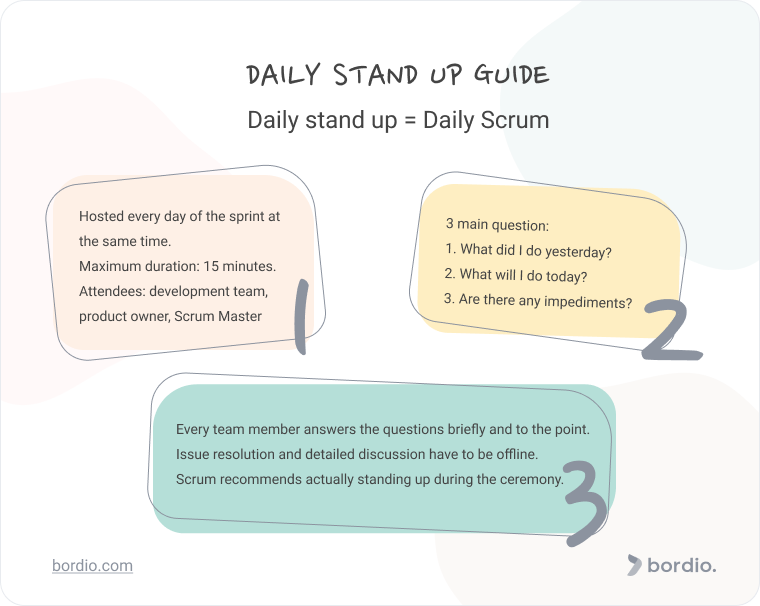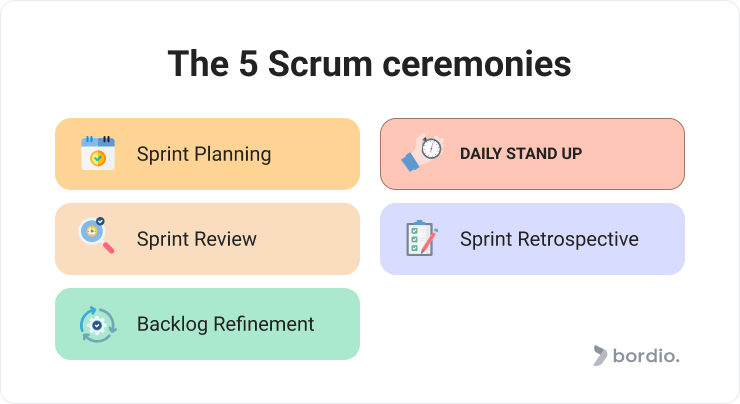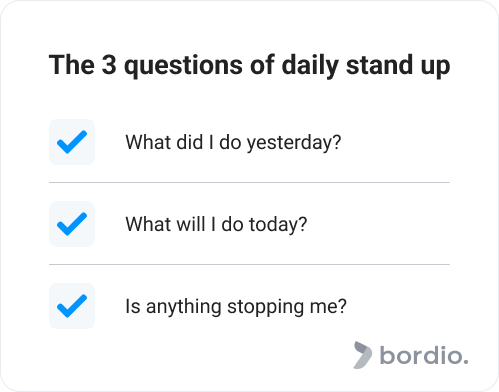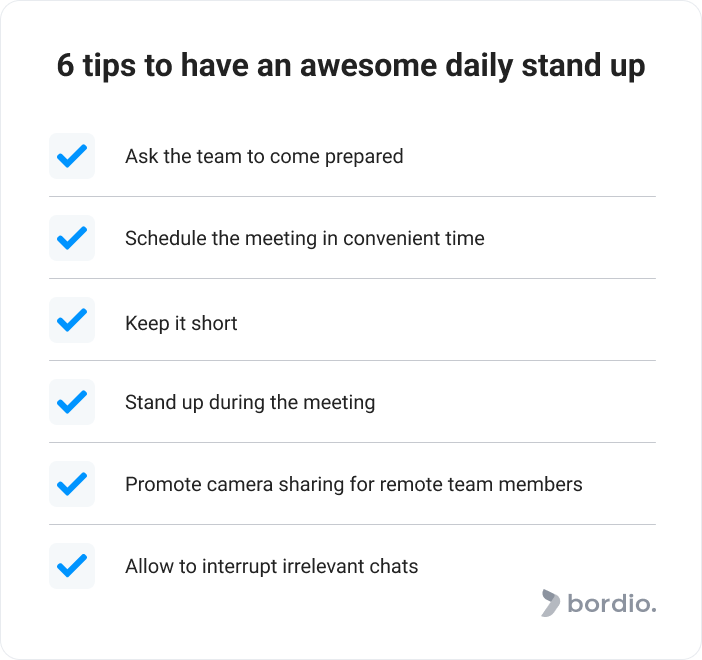If you’ve ever heard of Scrum, or watched any TV show about an IT project team, then you definitely saw the daily ceremony of a quick catch up meetings known as daily stand up.
Daily stand up meetings are one of the most well-known Scrum elements. And, just like the name suggests, it is an everyday event that is often held while literally standing. And before you disregard it as a motivational slash team-building game, it adds a lot of value to the entire process!
Today we will tell you all about daily stand ups: what they really are, why we need them, and how to run those meetings like a pro.
What is a daily stand up meeting?
Daily stand up, otherwise known as daily Scrum, is one of the five core Scrum ceremonies that the development team hosts during the sprint.
It is a short daily meeting that is very popular in project management because it brings the whole team together and helps everyone stay:
- Informed and on the same page.
- Connected with one another.
- Motivated to complete the sprint.
Traditionally, the daily standup has been hosted as a physical ceremony but it is currently often scheduled in the free planner online and done online via tools like Zoom or Google Meets which suits the remote teams better. Also for remote teams will be usefull to try remote working collaboration tools.
The daily stand up meeting agenda and format
The daily standup is usually scheduled in the team’s online calendar in the morning before the active workday starts. The recommended length is 15 minutes or less. And also check your personal time planner calendar.
The meeting is attended by the development team, the product owner, and the Scrum Master. Stakeholders can join but can’t interact. The product owner can choose to skip the meeting although they usually join to stay in the loop.
The meeting can be hosted by the Scrum Master or the product owner.
The format that the team uses during the stand up resembles sprint retrospective’s 3 key questions. In daily Scrum, each team member goes one-by-one answering to the following:
- What did I work on the day before?
- What will I work on today?
- Are there any obstacles on my way?
These questions must be prepared in advance in their task planner online.
Those simple questions go a long way. They highlight progress, as well as impediments, keep every single team member in the loop, and get everyone excited about the project.
Asynchronous daily standup meeting
Sometimes having a daily standup with every member of the team is just not possible. It could be because:
- There is too much of a time difference with remote team members spread across all continents.
- Everyone’s working schedules are heavily mismatched.
- Other unique reasons can disrupt the daily Scrum ceremony.
Whatever the reason for that in your project may be, it is not the end of the world.
Asynchronous stand ups can solve the issue and serve your Scrum team well. It is usually carried out via a messenger chat where every team member can join and leave comments whenever they come online. A team communication software
like Spike is a good option for something like this, as you can create channels specifically for these online stand ups. Additionally, using a text subscription can help ensure that team members receive timely reminders and updates about the stand-up meetings, keeping everyone on the same page. To make it more lively, some teams choose to add a personal touch to their updates and also comment something in the lines of the “mood of the day” or “wisdom of the day”. This helps keep the informal and friendly spirit in the chat.
Personally, we recommend going with live standup meetings when possible but not insist on it to the point of inconvenience. Yes, an asynchronous ceremony might not be as cool or fun but it is a working solution that has had a positive impact on many teams.
What a daily stand up meeting is NOT
Before we proceed with the rest of today’s article, let’s identify what daily standup meetings are not:
- Not a project status update meeting.
- Not a place to make excuses and be defensive. Haven’t done much the day before? That’s okay, don’t feel like you need to explain yourself during the daily call.
- Not a chance to justify your job description or job offer.
- Not a planning session. Use sprint planning for that!
- Not the right time for issue resolution. Ask for help but leave the actual work for another time.
- Not a time and place to schedule other meetings and activities.
Remember: there are only 15 minutes a day dedicated to the daily Scrum. This time should be used wisely and use the best daily schedule planner to make it easyer.
Tip: If you want to understand the difference between Scrum ceremonies better, check out the our sprint review and sprint retrospective comparison where we highlight the key differences between the two.
The 6 keys to having an engaging and effective standup meeting
A good daily Scrum meeting is:
- Flexible.
- To the point but open to discussion.
- Positive for all participants.
- Engaging.
The most effortless things take a lot of effort to create, so don’t worry if you host your first daily standups and they’re far from perfect. We prepared a few tips to help you master the game of the daily Scrum:
Ask the team to come prepared
The idea of the daily meeting is that it’s high-paced and we move from one team member to the next person rather quickly. They should do some time managing as well. So, if some Scrum team members take 5 minutes to just come up with something to say (which is usually not very relevant or exciting), it kills the mood for the rest. As a tip, suggest the development team focus on providing an update on the tasks that only they are working on.
Schedule the ceremony with the whole team in mind
Before scheduling the meeting in the online weekly planner, ask around: what time works for everyone? Just because the best practice is to have the daily Scrums early in the morning, it does not have to be that way in your team. Maybe you have offices across the globe and some team members on other continents struggle to join? Or there are a bunch of young parents who need to drive their kids to the nursery and join the ceremony remotely while on the road? The meeting needs to be a positive experience and not a struggle, so make sure you accommodate the needs of the entire team when scheduling.
Keep it short and follow daily stand up agenda
The standard 15 minutes are more than enough to collect updates from everyone, see what’s going on, and squeeze in a joke or two. Don’t make the meeting longer than it needs to be. Typical agile teams would be up to 9 people. If your team is much smaller, then maybe it makes sense to cut the time of the meeting.
Actually stand up during the meeting
If your daily stand up meetings are hosted in the conference room or the office space, stand up! Not only do you get a bit of extra movement but it also keeps people tuned in and motivates them to be efficient with their words.
Encourage camera sharing for online standup meetings
If your daily Scrum is hosted online, gently persuade your team to turn on their cameras. Most conference call apps these days support background blur, so your team members don’t need to worry about privacy, the mess of their homes, or anything else.
Stick to Agenda: Allow anyone to interrupt non-valuable chats
In terms of the daily stand ups, a chat that is not related to the three core questions is the chat that has no value. If some of the team members start discussing the details of the tasks or work on issue resolution, the rest don’t have to listen! Anyone should be able to point out politely that such discussions have to be had elsewhere.
Pro tip 1: remember to reach out to Scrum Master or any other dedicated Scrum expert on your team if you feel like something is not working. They are here to guide you and facilitate the Scrum methodology, so they would be the best people to ask for advice from. Because they can attend the ceremonies and witness what is working and what is not, they are your ultimate helpers on the Scrum Agile project management journey.
Pro Tip 2: if you feel like the daily stand up meetings are dull and people aren’t engaged, add some kind of visual board (like a Kanban board) where team members will leave their answers (or the meeting host will write them down). It will add some gamification to the ceremony and, if you make it digital, the remote team will also be able to have a look at it throughout the day whenever they want.
Bonus tip: Meetings can be hard to lead if the team is all shy and closed off. Consider adding ice breakers to your meetings, even the daily stand up. Just keep them short and fun, and rotate ice breaking activities to build excitement around the upcoming meeting. And also want to mention the team management app to use while planning the meeting.
Key takeaways on daily standup meetings
A daily standup meeting is not a project status meeting but a 15-minute event in your daily planner held at the same time and place to reduce complexities. You must use digital daily planner for teams to give access to others in your group.
The main purpose is to bring everyone on the same page by sharing how other team members are doing in terms of getting closer to achieving the sprint goal.
The meeting is called stand-up as people do really stand up a lot of the time. Such format allows to maintain a fast-paced attitude And it’s harder for individuals to go on and on cause others are waiting
The daily standup meetings keep the team energized and motivated. They boost team spirit and cooperation, make sure everyone stays on the right track with their personal to do list, and prevent issues. We recommend various project tools and task makers from Bordio.
To learn more about efficient project management, check out our article on Sprint Reviews, Scrum boards, and accountability in the hybrid workplace.









